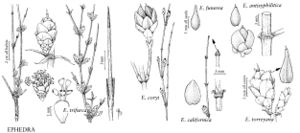Ephedraceae
Shrubs or vines, erect or clambering, Equisetum like, dioecious (very rarely monoecious). Bark gray to reddish-brown, cracked and fissured. Branches generally many, terete, whorled to fascicled, finely longitudinally grooved, internodes 1–10 cm. Roots generally fibrous. Leaves simple, opposite and decussate or whorled, scalelike, connate at base to form sheath, generally ephemeral, mostly not photosynthetic; resin canals absent. Pollen cones compound, 1–10 in whorls at nodes; each compound cone composed of 2–8 sets of opposite or whorled membranous bracts, proximal bracts empty, each distal bract subtending a small cone composed of 2 basally fused bracteoles subtending a sporangiophore bearing 2–10 (–15) sessile to long-stalked, bilocular, apically dehiscent, pollen-producing microsporangia. Pollen prolate, with 6–12 longitudinal furrows, not winged. Seed-cones compound, 1–10 in whorls at nodes of twigs; each compound cone sessile or on short to long peduncle, composed of 2–10 sets of overlapping, opposite or whorled, membranous or papery to fleshy bracts, proximal bracts empty, most distal bracts subtending 1 axillary cone composed of a pair of fused bracteoles enclosing a single-integumented ovule with integument projecting as tube from bracteole-envelope, envelope forming a leathery seed-coat that shed with seed. Seeds 1–2 (–3) per compound seed-cone, yellow to dark-brown, smooth or furrowed; cotyledons 2.
Distribution
Temperate and warm regions, worldwide except Australia.
Discussion
In addition to the characters given in the key to families, wood anatomy can be used to distinguish Ephedra from the other gymnosperms in the flora. Only Ephedra has small cones, ring porous wood, wide multiseriate rays, and vessels in older stems.
Since antiquity, several species of Ephedra have been used medicinally worldwide. Such uses include cough medicines, an antipyretic, an antisyphilitic, a stimulant for poor circulation, and an antihistamine. These uses are based on the presence of tannins and alkaloids, particularly ephedrines.
Genus 1, species ca. 60 (12 species in the flora).
